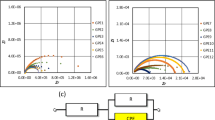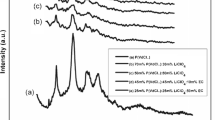Abstract
Lithium ion-conducting membranes with poly(ethylene oxide) (PEO)/poly(vinylidene chloride-co-acrylonitrile) (PVdC-co-AN)/lithium perchlorate (LiClO4) were prepared by solution casting method. Different plasticizers ethylene carbonate (EC), propylene carbonate (PC), gamma butyrolactone (gBL), diethyl carbonate (DEC), dimethyl carbonate (DMC), and dibutyl phthalate (DBP) were complexed with the fixed ratio of PEO/PVdC-co-AN/LiClO4. The preparation and physical and electrochemical properties of the gel polymer electrolytes have been briefly elucidated in this paper. The maximum ionic conductivity value computed from the ac impedance spectroscopy is found to be 3 × 10−4 S cm−1 for the EC-based system. From DBP-based system down to EC-based system, a decrease of crystallinity and an increase of amorphousity are depicted by X-ray diffraction technique, the decrease of band gap energy is picturized through UV–visible analysis, the decrease of glass transition temperature is perceived from differential scanning calorimetry plots, and the reduction of photoluminescence intensity is described through photoluminescence spectroscopy study at an excitation wavelength of 280 nm. Atomic force microscopic images of EC-based polymer electrolyte film show the escalation of micropores. Fourier transform infrared spectroscopy study supports the complex formation and the interaction between the polymers, salt, and plasticizer. The maximum thermal stability is obtained from thermogravimetry/differential thermal analysis, which is found to be 222 °C for the sample complexed with EC. The cyclic voltagram of the sample having a maximum ionic conductivity shows a small redox current at the anode, and cathode and the chemical stability is confirmed by linear sweep voltammetry.













Similar content being viewed by others
References
Croce F, Appetecchi GB, Persi L, Scrosati B (1998) Nanocomposite polymer electrolytes for lithium batteries. Nature 394:456–458
Scrosati B (2001) New approaches to developing lithium polymer batteries. Chem Rec 1:173–181
Wakihara M (2001) Recent developments in lithium ion batteries. Mater Sci Eng R Reports 33:109–134
Gray FM (1991) Solid polymer electrolytes—fundamentals and technological applications. VCH, New York
Fenton DE, Parker JM, Wright PV (1973) Complexes of alkali metal ions with poly(ethylene oxide). Polymer 14:589
Wright PV (1975) Electrical conductivity in ionic complexes of poly(ethylene oxide). Brit Polym J 7:319–327
Feuillade G, Perche P (1975) Ion-conductive macromolecular gels and membranes for solid lithium cells. J Appl Electrochem 5:63–69
Xu Q, Wan G (1993) Rechargeable Li/LiMn2O4 batteries with a polymeric solid electrolyte. J Power Sources 41:315–320
Selvaraj II, Chaklanobis S, Chadrasekhar V (1995) Conductivity studies on poly(methoxyethoxyethylmethacrylate)-lithium salt complexes. J Electrochem Soc 142:366–370
Huang B, Wang Z, Chen L, Xue R, Wang F (1996) The mechanism of lithium ion transport in polyacrylonitrile-based polymer electrolytes. Solid State Ionics 91:279–284
Wieczore KW, Florjanczyk Z, Stevens JR (1995) Composite polyether based solid electrolytes. Electrochim Acta 40:2251–2258
Maccallum JR, Smith MJ, Vincent CA (1981) The effects of radiation-induced crosslinking on the conductance of LiClO4/PEO electrolytes. Solid State Ionics 11:307–312
Watanabe M, Nagano S, Sanui K, Ogata N (1987) Structure-conductivity relationship in polymer electrolytes formed by network polymers from poly[dimethylsiloxane-g-poly(ethylene oxide)] and lithium perchlorate. J Power Sources 20:327–332
Inganäs O (1988) Electroactive polymer blends. Brit Polym J 20:233–236
Kim DW, Park JK, Rhee HW (1996) Conductivity and thermal studies of solid polymer electrolytes prepared by blending poly(ethylene oxide), poly (oligo[oxyethylenel]oxy sebacoyl) and lithium perchlorate. Solid State Ionics 83:49–56
Nagasubramanian G, Attia AI, Halpert G (1994) A polyacrylonitrile-based gelled electrolyte: electrochemical kinetic studies. J Appl Electrochem 24:298–302
Stallworth PE, Greenbaum SG, Croce F, Slane S, Salomon M (1995) Lithium-7 NMR and ionic conductivity studies of gel electrolytes based on poly(methylmethacrylate). Electrochim Acta 40:2137–2141
Morales JLA (1997) Thermal and electrical characterization of plasticized polymer. Solid State Ionics 96:99–106
Fan L, Nan CW, Dang Z (2002) Effect of modified montmorillonites on the ionic conductivity of (PEO)16LiClO4 electrolytes. Electrochim Acta 47:3541–3544
Croce F, Curini R, Martinelli A, Persi L, Ronchi F, Scrosati B (1999) Physical and chemical properties of nanocomposite polymer electrolytes. J Phys Chem B 103:10632–10638
Nann C-W (1993) Physics of inhomogeneous inorganic materials. Prog Mater Sci 37:1–116
Gozdz AS, Schmutz CN, Tarascon JM (1994) Rechargeable lithium intercalation battery with hybrid polymeric electrolyte, US patent 5296318A
Michot T, Nishimoto A, Watanabe M (2000) Electrochemical properties of polymer gel electrolytes based on poly(vinylidene fluoride) copolymer and homopolymer. Electrochim Acta 45:1347–1360
Shi Q, Yu M, Zhou X, Yan Y, Wan C (2002) Structure and performance of porous polymer electrolytes based on P(VDF-HFP) for lithium ion batteries. J Power Sources 103:286–292
Zulfiqar S, Ahmad S (1999) Thermal degradation of blends of PVC with polysiloxane—1. Polym Degrad Stab 65:243–247
KiranKumar K, Ravi M, Pavani Y, Bhavan S, Sharma AK, Narasimha Rao VVR (2011) Investigations on the effect of complexation of NaF salt with polymer blend (PEO/PVP) electrolytes on ionic conductivity and optical energy band gaps. Physica B 406:1706–1712
Shanthi M, Mathew CM, Ulaganathan M, Rajendran S (2013) FT-IR and DSC studies of poly(vinylidene chloride-co-acrylonitrile) complexed with LiBF4. Spectrochim Acta A 109:105–109
Painter PC, Coleman MM (1997) Fundamentals of polymer science: an introductory text. Technomic Publishing, Lancaster
Garton A (1992) Infrared spectroscopy of polymer blends, composites and surfaces. Carl Hanser Verlag, Munich
Krimm S, Liang CY (1956) Infrared spectra of high polymers. IV. Poly(vinyl chloride), poly(vinylidene chloride), and copolymers. J Polym Sci 22:95–112
Suthanthiraraj SA, Sheeba DJ (2007) Structural investigation on PEO-based polymer electrolytes dispersed with Al2O3 nanoparticles. Ionics 13:447–450
Papke BL (1982) Vibrational spectroscopic determination of structure and Ion pairing in complexes of poly(ethylene oxide) with lithium salts. J Electrochem Soc 129:1434–1438
Rigas B, Morgellon S, Goldman IS, Wong PT (1990) Human colorectal cancers display abnormal Fourier-transform infrared spectra. Proc Natl Acad Sci U S A 87:8140–8144
Bertie JE, Othen DA (1973) On the assignment of the infrared spectrum of ethylene oxide. Can J Chem 51:1155–1158
Wen SJ, Richardson TJ, Ghantous DI, Striebel KA, Ross PN, Cairns EJ (1996) FTIR characterization of PEO + LiN(CF3SO2)2 electrolytes. J Electroanal Chem 408:113–118
Ostrovski D, Brodin A, Torell M, Appetecchi GB, Scrosati BJ (1998) Molecular and ionic interactions in polyacrylonitrile- and poly(methylmetacrylate)-based gel electrolytes. J Chem Phys 109:7618–7624
Watanabe M, Ogata N, MacCullum JR, Vincent CA (1987) Polymer electrolyte review, vol 1. Elsevier, New York
Sung HY, Wang YY, Wan CC (1998) Preparation and characterisation of poly(vinyl chloride-co-vinyl acetate)-based gel electrolytes for Li-ion batteries. J Electrochem Soc 145:1207–1211
Abraham KM, Alamgir M, Hoffman DK (1995) Polymer electrolytes reinforced by Celgard membranes. J Electrochem Soc 142:683–687
Mark HF (1964) Encyclopedia of polymer science and engineering, vol 1. Wiley Interscience Publication, John Wiley & Sons, New York
Ulaganathan M, Rajendran S (2010) Li ion conduction on plasticizer-added PVAc-based hybrid polymer electrolytes. Ionics 16:667–672
Mathew CM, Kesavan K, Rajendran S (2014) Analysis of plasticizer influence in poly(vinyl acetate)/poly(vinylidene fluoride) polymer blend electrolyte. Ionics 20:439–443
Miyamoto T, Shibayama K (1973) Free-volume model for ionic conductivity in polymers. J Appl Phys 44:5372–5376
Ulaganathan M, Pethaiah SS, Rajendran S (2011) Li-ion conduction in PVAc based polymer blend electrolytes for lithium battery applications. Mater Chem Phys 129:471–476
Wen Z, Itoh T, Ikeda M, Hirata N, Kubo M, Yamamoto O (2000) Characterization of composite electrolytes based on a hyperbranched polymer. J Power Sources 90:20–26
Wang H, Huang H, Wunder SL (2000) Novel microporous poly(vinylidene fluoride) blend electrolytes for lithium-Ion batteries. J Electrochem Soc 147:2853–2861
Hayamizu K, Aihara Y, Price WSJ (2000) Correlating the NMR self-diffusion and relaxation measurements with ionic conductivity in polymer electrolytes composed of cross-linked poly(ethylene oxide-propylene oxide) doped with LiN(SO 2CF3) 2. J Chem Phys 113:4785–4793
Park US, Hong YJ, Oh MS (1996) Fluorescence spectroscopy for local viscosity measurements in polyacrylonitrile (PAN)-based polymer. Electrochim Acta 41:849–855
Aravindan V, Vickraman P, Kumar TP (2008) Polyvinylidene fluoride-hexafluoropropylene (PVdF-HFP)-based composite polymer electrolyte containing LiPF3(CF3CF2)3. J Non-Cryst Solids 354:3451–3457
Pankove JI (1971) Optical processes in semiconductors. Prentice-Hall, Englewood Cliffs
Abdelaziz M, Ghannam MM (2010) Influence of titanium chloride addition on the optical and dielectric properties of PVA films. Physica B 405:958–964
Maouche N, Nessark B (2011) Cyclic voltammetry and impedance spectroscopy behavior studies of polyterthiophene modified electrode. Int J Electrochem Sci 2011:1–5
Meher SK, Justin P, Rao GR (2011) Microwave-mediated synthesis for improved morphology and pseudocapacitance performance of nickel oxide. ACS Appl Mater Inter 3:2063–2073
Appetecchi GB, Croce F, Scrosati B (1997) High-performance electrolyte membranes for plastic lithium batteries. J Power Sources 66:77–82
Abidin SZZ, Ali AMM, Hassan OH, Yahya MZA (2013) Electrochemical studies on cellulose acetate-LiBOB polymer gel electrolytes. Int J Electrochem Sci 8:7320–7326
Author information
Authors and Affiliations
Corresponding author
Rights and permissions
About this article
Cite this article
Subbu, C., Rajendran, S., Kesavan, K. et al. The physical and electrochemical properties of poly(vinylidene chloride-co-acrylonitrile)-based polymer electrolytes prepared with different plasticizers. Ionics 22, 229–240 (2016). https://doi.org/10.1007/s11581-015-1535-7
Received:
Revised:
Accepted:
Published:
Issue Date:
DOI: https://doi.org/10.1007/s11581-015-1535-7




